How to Paint Skies: “Whether playing the lead or a supporting role in your paintings, understanding the nature of the sky and learning to paint it in all its manifestations is an important skill for any landscape painter.” John MacDonald explains.
Reaching for the Skies
by John MacDonald
(The following is an excerpt from John MacDonald’s newsletter. Visit his website at jmacdonald.com. John is featured in the art video workshops “Poetic Landscapes, Creating Dynamic Landscapes, and Mastering Values.”
In troubled times, nothing is more restorative than immersing ourselves in the all-embracing sky. Sunny or stormy, its constant beauty and transient nature serve as a reminder that everything beneath it, no matter how unpleasant, will pass in time.
Before launching yourself into the skies, ask yourself these important questions:
How important is the sky to the message of the painting?
What is your intention–what do you want to say in the painting and where do you want the eye to go? Is the sky an essential part of the message or is it merely a backdrop for what’s taking place on the ground? Don’t begin the painting until you’re clear about your intention.
The more important the sky is in the painting, the more contrasts you’ll need in the sky to attract and hold the eye. And if it’s the entire message of the painting, you’ll want to diminish or eliminate contrasts in the landscape below that could detract from those in the sky.
Where do you want the horizon line?
The more important the sky is to the painting, the larger it should be on the canvas, right? Not necessarily. Remember, it’s contrasts that draw the eye and establish a focal area. Strong contrasts of value, color, edges, and details will attract the eye to the sky regardless of its size on the canvas.
That said, the placement of the horizon line can affect the message of the painting. A high horizon line implies looking down, which emphasizes the fore and middle ground. A high horizon will always place more emphasis on the ground than the sky, but it doesn’t necessarily mean the sky is unimportant. It’s not the size of the shapes of things on the canvas that attracts the eye, it’s the strength of the contrasts within the shapes.
A worm’s eye view of a landscape–a low horizon line–implies looking upward into space. If the focal area is in the sky, consider placing the horizon line below the midpoint of the canvas.
Sky vs. Ground
In Birge Harrison’s book, “Landscape Painting,” (pub. 1910), he writes, “…of all the rules of composition … The first and by far the most important of these is, ‘don’t try to say two things on one canvas.’”
When considering a scene to paint, it’s not unusual to find the sky and the ground equally interesting. If you try to capture both, the result will be two equal focal areas and the painting will fail. Choose one area–sky or ground–to emphasize with contrasts and then simplify or silence the contrasts in the other. Or do two paintings!
The closer you place the horizon line to the middle of a painting, the more likely you are to encounter this problem. It’s not necessary to change the horizon line (unless you want to), simply put different amounts of contrasts in the two areas.
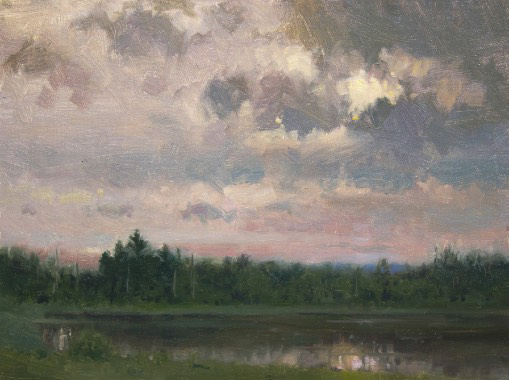
Sky Gradients
A sky isn’t a flat backdrop on a stage. It has volume and depth. One of the easiest ways to create a sense of depth is through the use of gradients: a gradual change in value, hue, and/or saturation across the shape of the sky. Even if the sky is relatively unimportant to the painting, it’s nearly always necessary to create one or more gradients to prevent it from appearing as a flat shape stuck on the surface of the canvas.
The most common sky gradient is that of a darker top moving to a lighter horizon but it can also shift from a dark horizon to a light top or a gradient that moves from side to side. Look for the gradients in nature. They’re always there!
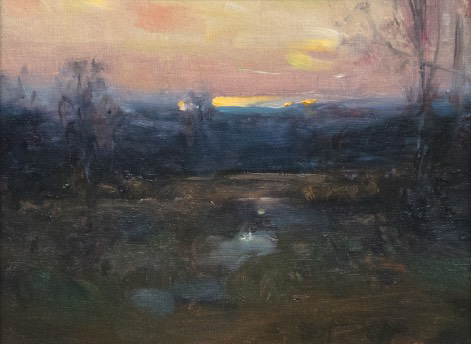
Value Contrasts in the Sky
Nothing grabs the eye with greater power than value contrast. It will overwhelm all other forms of contrast.
When analyzing the range of values in the sky, especially cloudy skies, it’s crucial to continually compare the values of the sky with those in the entire scene. If we focus exclusively on the sky, the eye will exaggerate the value contrasts and we will tend to make the darks in the sky far too dark unless, of course, a stormy sky is the subject matter of the painting.
Color Contrast in the Sky
In a sky, color contrasts work in two ways: first, the overall color contrast between the sky and ground (e.g., a warm sky against a cool ground) and, second, the shifts of warm and cooler colors within the sky, whether it’s warm, cool, or neutral. Of the two, it is the color contrasts within a sky that create the illusion of the luminosity of light and depth.
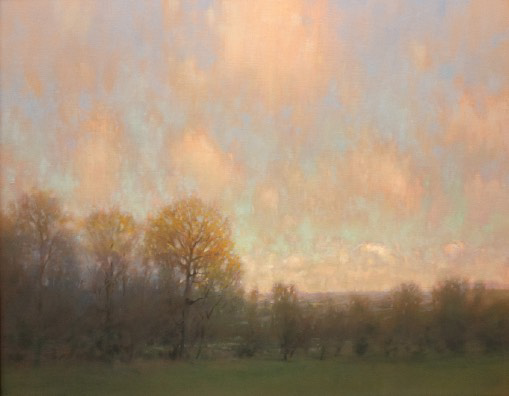
Color Contrast–Clouds
Color contrast isn’t limited to blue skies. Clouds, too, require color contrast to give them luminosity and translucency.
Because color contrasts are stronger when values are kept close together, deliberately limit the number of values in your clouds as much as possible, making temperature color changes rather than value changes.
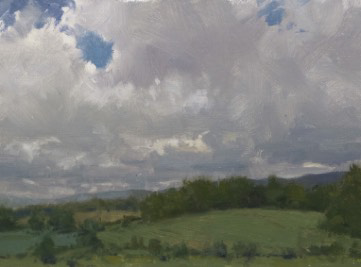
Cloud Edges
If your painting goal is to create believable illusions of light, space, and atmosphere, avoid using hard edges in your clouds. They will flatten the clouds and the sky, drawing attention to the surface of the canvas. However, if you wish to emphasize the graphic quality of your composition, then use uniformly hard edges on ALL the forms in the painting.
But first, decide which result you want. Do you prefer a graphic, 2-D space, or a realistic 3-D space? Both approaches can result in beautiful paintings but don’t mix them! Creating hard-edged clouds in an otherwise realistic, soft-edged landscape will flatten the sky and destroy any illusion of representational space.
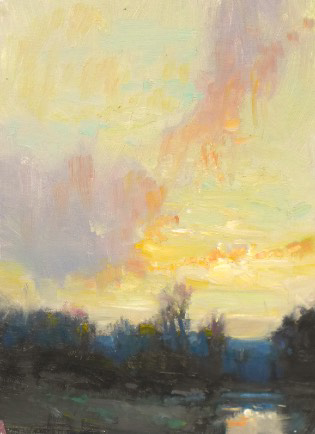
Cloudy Skies ~ Looking with the Sun
If the light source is behind with the light shining fully on the scene ahead, the values in the sky tend to fall in the middle of the value scale. Scattered highlights and shadows emphasize the 3-D form of the clouds–giving them volume and spacial depth. With most values clustered in the middle of the value scale, it’s the color contrasts, not value contrasts, that will bring life to the sky. In this case, take advantage of the limited value range and push the color.
Cloudy Skies ~ Contre Jour (Looking into the Sun)
When looking into the light source, the values in the sky can range from white to nearly black. Clouds are reduced to silhouetted flat shapes, emphasizing their graphic quality and the design of the composition. Here, value contrasts become more important than color contrasts, with a need to create darks that enhance the illusion of glaring light. All of the values in the painting follow a gradient from the lightest at the light source to a gradual darkening toward the edges of the painting. The greater the value range, the greater the illusion of dramatic light.
Sky Examples
Below are some paintings in which the sky is an important feature, helping to establish the mood, the illusion of light, the time of day, and the conditions of the weather.
Whether playing the lead or a supporting role in your paintings, understanding the nature of the sky and learning to paint it in all its manifestations is an important skill for any landscape painter. And what could be more fun than spending time soaring through an open sky?
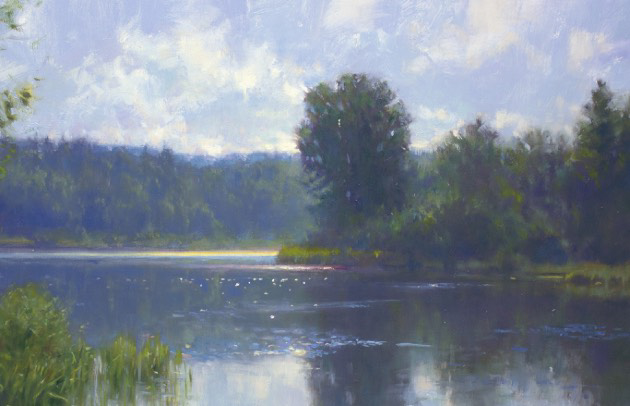
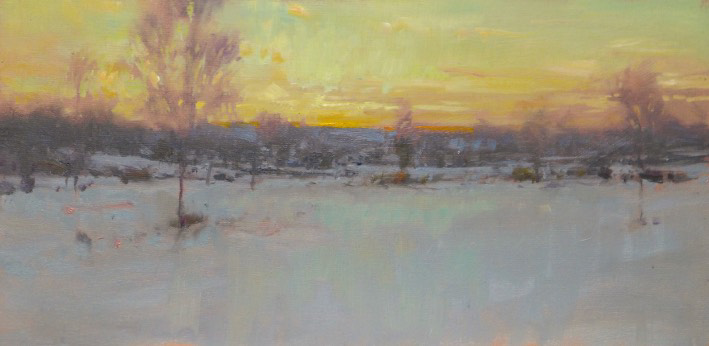
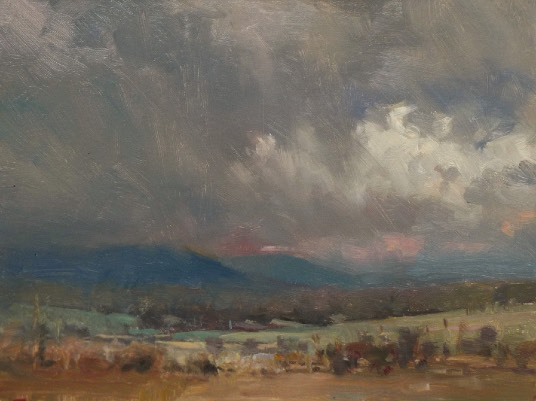
Read the full article and see more examples of how to paint skies in John MacDonald’s Jan/Feb 2021 newsletter.
Visit John’s website at jmacdonald.com and check out his art video workshops “Poetic Landscapes, Creating Dynamic Landscapes, and Mastering Values.”
Visit EricRhoads.com to find out all the amazing opportunities for artists through Streamline Publishing, including:
– Online art conferences such as Plein Air Live
– New video workshops for artists
– Incredible art retreats
– Educational and fun art conventions, and much more.
> Subscribe to Plein Air Today, a free newsletter for artists
> Subscribe to PleinAir Magazine so you never miss an issue

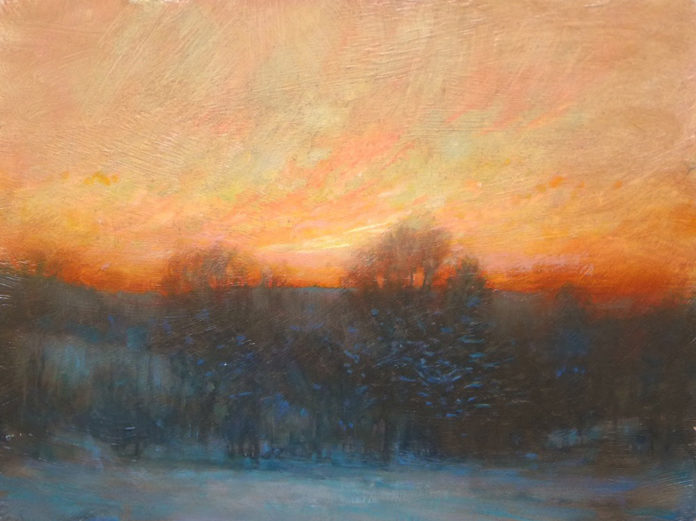




Hello, Yesterday I heard a Plein Air Podcast by Eric Rhoads with artist, Mike Hernandez. I would like to view some of his videos on streamline art. Thank you.
Hello, Phyllis! Thank you for asking about them. You can find Mike’s (and John’s, and many more) videos at https://painttube.tv/search?type=product&q=hernandez. Happy painting!